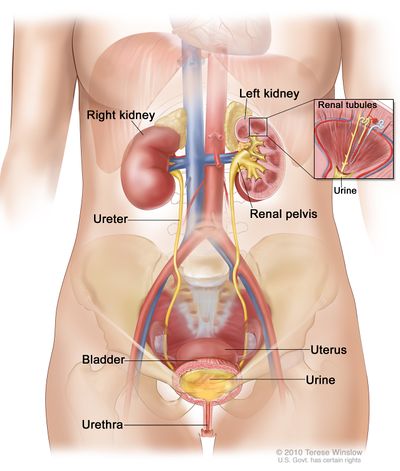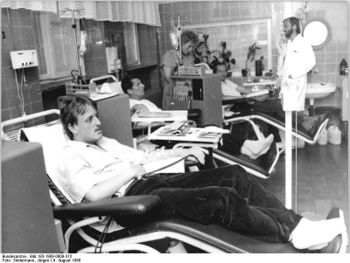Chronic Kidney Disease: Difference between revisions
No edit summary |
No edit summary |
||
| Line 48: | Line 48: | ||
== Classification == | == Classification == | ||
[[File:Dialysis.jpg|right|frameless|350x350px]] | |||
Chronic kidney disease can be classified in a variety of ways. A common classification divides CKD into five stages based on the GFR (ml/min/1.73 m2) | Chronic kidney disease can be classified in a variety of ways. A common classification divides CKD into five stages based on the GFR (ml/min/1.73 m2) | ||
* stage 1: >90: kidney damage with normal or elevated GFR | * stage 1: >90: kidney damage with normal or elevated GFR | ||
| Line 58: | Line 59: | ||
== Clinical Presentation == | == Clinical Presentation == | ||
Clinical presentation depends a lot on aetiology. | Clinical presentation depends a lot on aetiology. | ||
* Children with chronic kidney disease can have growth disorder, oedema and cola coloured urine (due to RBC casts). | * Children with chronic kidney disease can have growth disorder, [[Edema Assessment|oedema]] and cola coloured urine (due to RBC casts). | ||
* Adults can have non-specific symptoms like nausea, vomiting, weight loss, and easy fatigability. | * Adults can have non-specific symptoms like nausea, vomiting, weight loss, and easy fatigability. | ||
* Hypertension is common in adults with chronic kidney disease<ref name=":0" />. | * Hypertension is common in adults with chronic kidney disease<ref name=":0" />. | ||
| Line 69: | Line 70: | ||
== Interprofessional team == | == Interprofessional team == | ||
[[File:Exercise Bike.gif|right|frameless|100x100px]] | |||
The management of kidney failure is usually done with an interprofessional team of healthcare professionals dedicated to preserving renal function. Kidney failure has enormous morbidity and mortality, costing the healthcare system billions of dollars each year. Only through open communication between the team members can the morbidity and mortality of renal failure be lowered. | The management of kidney failure is usually done with an interprofessional team of healthcare professionals dedicated to preserving renal function. Kidney failure has enormous morbidity and mortality, costing the healthcare system billions of dollars each year. Only through open communication between the team members can the morbidity and mortality of renal failure be lowered. | ||
* Today most hospitals have a kidney failure nurse whose job is to educate patients on the causes, detection, and prevention of kidney failure. | * Today most hospitals have a kidney failure nurse whose job is to educate patients on the causes, detection, and prevention of kidney failure. | ||
Revision as of 08:31, 20 October 2020
This article or area is currently under construction and may only be partially complete. Please come back soon to see the finished work! (20/10/2020)
Original Editor - Lucinda hampton
Top Contributors - Lucinda hampton, Bruno Serra, Vidya Acharya and Kim Jackson
Introduction[edit | edit source]
Chronic kidney disease (CKD):
- A progressive loss of glomerular function caused by a long-standing renal parenchymal disease. It is present when the glomerular filtration rate (GFR) is less than 60 ml/min/1.73 m2 for three consecutive months or greater than or equal to this value in patients with a kidney damage that is present for three or more months.[1]
- A non-communicable disease usually caused by diabetes and hypertension[2]
- Often involves a progressive loss of kidney function necessitating renal replacement therapy (dialysis or transplantation). When a patient needs renal replacement therapy, the condition is called end-stage renal disease (ESRD)[3].
Function[edit | edit source]
Filter the blood to remove excess water, minerals, and waste products of protein metabolism, producing urine in the process
Kidneys are involved in
- Blood pressure regulation
- Regulation of body fluid volume, osmolality and pH
- Vitamin D and red blood cell (RBC) production
Renal function tests
- Estimated glomerular filtration rate (eGFR)
- Electrolytes
- Blood urea nitrogen (BUN) (urea in the UK)
- Creatinine levels[4]
Epidemiology[edit | edit source]
CKD is a prevalent disease, affecting between 10-15% of the adult population globally[1]
- The true incidence and prevalence of CKD are difficult to determine because of the asymptomatic nature of early to moderate CKD.
- The prevalence of CKD is around 10% to 14% in the general population[5].
- Worldwide, CKD accounted for 2,968,600 (1%) of disability-adjusted life-years and 2,546,700 (1% to 3%) of life-years lost in 2012.
- In 2017, the global prevalence of CKD was 9·1%, roughly 700 million cases.
- Since 1990, the prevalence of CKD has increased by 29·3%.
- A substantial increase was noted in age-standardised incidence of end-stage kidney disease (ESKD) treated by renal replacement therapy, with dialysis and kidney transplantation increasing by 43·1% and 34·4%, respectively.
- The global age-standardised mortality rate for CKD is not declining, unlike those for other important non-communicable diseases.[2]
Etiology[edit | edit source]
The causes of CKD vary globally, and the most common primary diseases causing CKD and ultimately end-stage renal disease (ESRD) are as follows:
- Diabetes mellitus type 2 (30% to 50%)
- Diabetes mellitus type 1 (3.9%)
- Hypertension (27.2%)
- Followed by - Primary glomerulonephritis (8.2%), Chronic Tubulointerstitial nephritis (3.6%), Hereditary or cystic diseases (3.1%), Secondary glomerulonephritis or vasculitis (2.1%), Plasma cell dyscrasias or neoplasm[5].
Risk Factors for Progression of CKD
- Non-Modifiable CKD Risk Factors - Older age, male gender, a non-Caucasian ethnicity
- Modifiable CKD Risk Factors - Include systemic hypertension, proteinuria, obesity, smoking, metabolic factors such as insulin resistance, dyslipidemia, and hyperuricemia[5].
Classification[edit | edit source]
Chronic kidney disease can be classified in a variety of ways. A common classification divides CKD into five stages based on the GFR (ml/min/1.73 m2)
- stage 1: >90: kidney damage with normal or elevated GFR
- stage 2: 60-89: kidney damage with mild reduction in GFR
- stage 3: 30-59: moderate reduction in GFR, this can be further sub divided as 5
- stage 3a: 59-45; stage 3b: 44-30
- stage 4: 15-29: severe reduction in GFR
- stage 5: <15 (or dialysis): end-stage kidney disease (ESKD)[1]
Clinical Presentation[edit | edit source]
Clinical presentation depends a lot on aetiology.
- Children with chronic kidney disease can have growth disorder, oedema and cola coloured urine (due to RBC casts).
- Adults can have non-specific symptoms like nausea, vomiting, weight loss, and easy fatigability.
- Hypertension is common in adults with chronic kidney disease[1].
Management[edit | edit source]
General Management: Adjusting drug doses for the level of estimated glomerular filtration rate (GFR); Preparation of renal replacement therapy by placing an arteriovenous fistula or graft
- Treat the Reversible Causes of Renal Failure
- Retarding the Progression of CKD - The factors which result in progression of CKD should be addressed such as hypertension, proteinuria, metabolic acidosis, and hyperlipidemia.
- Preparation and Initiation of Renal Replacement Therapy - Patients with CKD should be referred to a nephrologist when the estimated GFR is less than 30 ml/min/1.73 mt2. This is the time to discuss the options of renal replacement therapy[5]
Interprofessional team[edit | edit source]
The management of kidney failure is usually done with an interprofessional team of healthcare professionals dedicated to preserving renal function. Kidney failure has enormous morbidity and mortality, costing the healthcare system billions of dollars each year. Only through open communication between the team members can the morbidity and mortality of renal failure be lowered.
- Today most hospitals have a kidney failure nurse whose job is to educate patients on the causes, detection, and prevention of kidney failure.
- The pharmacist also needs to regularly audit the patient.
- The physiotherapist is involved in exercise (See Renal Rehabilitation)
- These patients should have close follow up to ensure that the renal function is not deteriorating.
- The patient needs to be given advice on healthy eating, discontinuing tobacco and abstaining from alcohol.
- Kidney disease if not well managed can lead to complete renal failure, which requires dialysis[5].
Resources[edit | edit source]
- bulleted list
- x
or
- numbered list
- x
References[edit | edit source]
- ↑ 1.0 1.1 1.2 1.3 Radiopedia CKD Available from:https://radiopaedia.org/articles/chronic-kidney-disease (last accessed 20.10.20)
- ↑ 2.0 2.1 Cockwell P, Fisher LA. The global burden of chronic kidney disease. The Lancet. 2020 Feb 29;395(10225):662-4.Available from:https://www.thelancet.com/journals/lancet/article/PIIS0140-6736(19)32977-0/fulltext (last accessed 20.10.2020)
- ↑ Radiopedia Kidney Failure Available from:https://www.ncbi.nlm.nih.gov/books/NBK519012/ (last accessed 20.10.2020)
- ↑ Radiopedia Kidneys Available from:https://radiopaedia.org/articles/kidneys (last accessed 20.10.2020)
- ↑ 5.0 5.1 5.2 5.3 5.4 Vaidya SR, Aeddula NR. Chronic Renal Failure. InStatPearls [Internet] 2019 Dec 7. StatPearls Publishing.Available from:https://www.ncbi.nlm.nih.gov/books/NBK535404/ (last accessed 20.10.2020)









